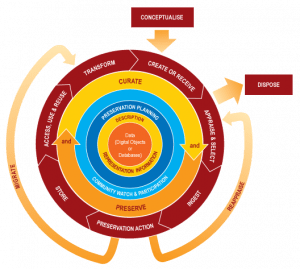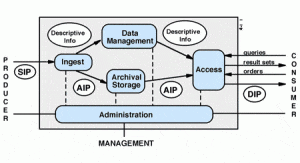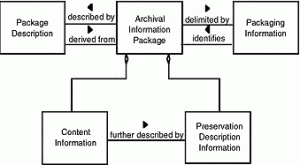1. The DCC Curation Lifecycle Model
According to the Digital Curation Centre’s (DCC) Lifecycle Model a data curation project (digital objects or databases, see circle centre) can be divided into 4 main overarching actions that are then subdivided into practical steps:
-
First Action: Description and representation of information
Use appropriate standards in order to describe metadata so that it can be controlled over the long term. Ensure that all metadata and associated digital material can be represented and understood in appropriate formats
-
Second Action: Preservation planning
Preservation must be thought through and planned during the data lifecycle. Creating a strategy for preservation requires the management and administration of data and metadata creation throughout its lifecycle.
-
Third Action: Community watch and participation
It is important to create a strong sense of collaborative effort. Exchange of ideas and tools are a stable in the DC community. Community watch and participation improves the quality of work and contributes to the collective creation and sharing of the standards to be used and the appropriate tools and software to create and preserve data.
-
Fourth Action: Curate and Preserve
The curator must actively promote curation and preservation throughout the lifecycle. Maintaining control on the creation of data and metadata and promoting best practices through policies and standards will improve the overall organisation of data.
2. Practical steps
The four main actions, to be carried simultaneously, are embedded in the practical steps appropriate for a digital curation project:
-
Conceptualise: Build a strategy and policy that will address how data will be captured and stored
-
Create or Receive: Create data using descriptive and technical metadata; also include preservation metadata if appropriate
-
Appraise and Select: Create an appraisal and selection policy with data creators and curators.
-
Ingest: After appraisal and selection have been completed, take custody of the data and transfer to an archive or repository and adhere to the guidelines that were created.
-
Preservation: Take steps to ensure the long-term preservation of authoritative nature of data. Apply digital forensics and establish evidence. From an archivist’s perspective, data must remain authentic, reliable and usable while maintaining its integrity. (For electronic records and data see the InterPARES 2 Project )
-
Store: Store data using appropriate standards
-
Access, Reuse and Retrieval: Think about users and stakeholders needs and make sure that data remain accessible and usable.
-
Transform: This requires creating new data from the original material to be used and reused. Transforming data can mean turning it into a different format or creating related information.
3. The OAIS Reference Model
The Open Archival Information System (OAIS) Reference Model is a widely adopted international standard (ISO 14721: 2012) for managing digital materials in a digital archiving system. It provides a generic framework for building a digital archive and is applicable to most actions in the curation lifecycle. It provides a vocabulary of preservation concepts shared by people with different skillsets and backgrounds, it defines an informational model and a functional model (describes the key functions needed in a digital archive. [1]
Key concepts:
Submission Information Package (SIP), Archival Information Package (AIP), Dissemination Information Package (DIP):
the physical structure of an information package will include files, checksums, logs, submission documentation, XML metadata, etc.
Information Object:
is defined as a data object (usually digital bits) together with its representation information object, which gives the format and meaning of the digital object bits
This highlights the importance of the format and meaning descriptions needed to turn bits into information.[2]
The Archival Information Package (AIP) is a concept for identifying a collection of information that can be preserved over the long term. This is a basic representation of its structure.
There is a lot of material online (here, here, here and in more detail here) to read further on the OAIS model.
In brief: The Ingest entity is the process of accepting information, the Submission Information Package (SIP), provided from Producers and preparing the contents for storage and management within the archive. Ingest functions include receiving SIP, performing quality assurance on SIP, generating an Archival Information Package (AIP) which complies with the archive’s data formatting and documentation standards, extracting Descriptive Information from the AIP for inclusion in the archive database, and coordinating updates to Archival Storage and Data Management.
The Archival Storage entity provides the services and functions for the storage, maintenance and retrieval of AIP held by the archive.
The Data Management entity supports access and updates information. It coordinates the Descriptive Information of the AIP.
The Administration entity manages the day-to-day operation of the archive system.
The Access entity supports consumers. It is the interface with the Designated Community in determining the existence, description, location and availability of information stored in the OAIS and allowing Consumers to request and receive information products (Dissemination Information Packages, result sets, reports).
Even though the above presentation may seem too abstract and theoretical, I found it useful having the lifecycle and reference model mentally and visually present, in order to think how it applied to my project. In the case of the lifecycle, there are steps I have followed and steps I have skipped due to the circumstances of receiving data rather than creating and of not having an original plan or design.
I have adapted the plan to suit the context of this project and the resources I had available; however, I do find that the missing steps are in fact very present in their absence. In my next post I will discuss how I practised the process of ingest.
[1] Oliver, Digital curation / Gillian Oliver, Ross Harvey, 37-42.
[2] Don Sawyer, “The Open Archival Information System and the NSSDC



